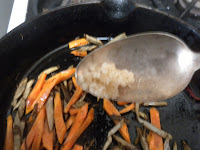Field Notes. Like that old song - what a difference a day makes! Spring arrived Sunday as I was finishing syrup, and I had all the windows open. Now we head outside, and are monitoring temperatures in all the growing spaces. Like Goldilocks we don't want it too hot or too cold, but just right! From 70's to freezing outside with more heat possible inside means opening and closing most days.
For Ken the push is on. He has been cleaning up the sap buckets and other equipment and is starting to plant outside the covered areas. So much to catch up this season! It feels great to get over wintered roots out of the ground, and crops into the ground. Ah, spring!
Ken has also been working for our event here this weekend.

And I have been washing and pricing pottery that will be for sale.
From the Kitchen. Spring roots always add variety to the winter's fare. This week we add parsnips and burdock. Parsnips are a carrot cousin - only sweeter. The old fashioned way to serve them is scrub, slice, boil or steam to al dente, and then saute in butter until they just start to brown and caramelize. They are great in soups. I like a creamed potato, parsnip and curry soup.
Burdock is a new vegetable for many people. It is common in Asia where people consider it a health food - packed with minerals and eaten as a blood and liver tonifier and spring cleanse. I usually do a Japanese cooking style called kinpira.
 What is kinpira? Kinpira is a Japanese cooking
technique.
What is kinpira? Kinpira is a Japanese cooking
technique. In spring one uses carrots and gobo - burdock root - cut into matchsticks. In summer chefs combine thumb sized pieces of Asian eggplant and green pepper. And in fall squash like our buttercup cut into thin crescent shapes is common.
Start with a cast iron or heavy skillet. Toast some sesame seeds and set aside. Use a cooking fat or oil that can take heat, and add some dried hot red pepper flakes if desired.
 Add the vegetable that takes the longer cooking time (gobo
in spring and green peppers in summer).
Add the vegetable that takes the longer cooking time (gobo
in spring and green peppers in summer). Cook over high heat, and keep stirring.
Add the second vegetable. Cook to al dente.
Add a teaspoon to tablespoon of sugar, Stir to caramelize, but don't burn.
Add a splash at a time of a sweet cooking wine like Japanese mirin or sherry. I use homemade parsnip wine.
Finally add some good quality tamari or soy sauce. Top with the toasted sesame seeds and serve.
The sequence is important as the sugar and sweet wine seal in the flavors. Experiment as everyone seems to like a different ratio - some like it hotter, others like it sweeter or saltier. The end result is a toasted sweet, salty glazed vegetable with a bit of crunch. Delicious!
Til next week!











No comments:
Post a Comment